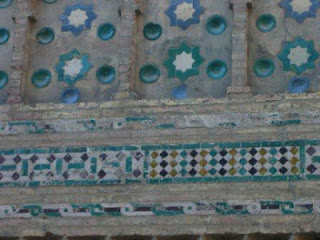Ceramic tile use throughout Spain is prolific. Not only can it be seen on the floors and walls of Aragonese countryside homes, but ceramic tile also plays an integral role in the everyday functioning of many embellished palatial royal dwellings. It wasn’t until 2011 when I realized just how much of a role ceramic tile played, not only in the current day-to-day daily life of Spaniards, but the depth and complexity of historical value.
 |
| The Basilica Nuestra Senora del Pilar, as viewed from across the Ebro river, features vibrant blue, green, yellow, white and ceramic tile on its main dome, as well as its 10 smaller domes. |
Last year, along with four members of the architecture and design (A&D) community, I was asked to join the second edition Tile of Spain’s “Reign in Spain A&D Tour.” Tile of Spain is the umbrella brand managed jointly by the Trade Commission of Spain in Miami, FL, and the Spanish Ceramic Tile Manufacturer’s Association (ASCER) in Valencia, Spain. The annual media tour to Spain coincided with Cevisama, the International Ceramic Tile and Bath Furnishings Show held in Valencia.
The group of architects, interior designers and journalists, including myself, traveled to the cities of Zaragoza, Teruel and Valencia – admiring the Spanish architecture, culture, and culinary temptations – with Cevisama being our final destination.
Shortly after our arrival to Spain, we were taken to Zaragoza, the capital of the region of Aragon. Located on the banks of the Ebro River, halfway between Madrid and Barcelona, Zaragoza hosted Expo Zaragoza in 2008, where the country showcased its commitment to water conservation, the preservation of the environment and its utilization of sustainable practices. Of course, ceramic tile and terracotta played an integral role in all of this.
 |
| The Spanish Pavilion on the grounds of the 2008 Water Expo features 750 terracotta pillars. |
 |
| The Conference Center of Aragon utilizes 120,000 triangular pieces of ceramic tile on the exterior walls and roof lines. |
Walking through the Plaza de la Seo in Zaragoza, we came upon two basilicas, the Cathedral of San Salvador (La Leo) and Nuestra Senora del Pilar. Without a doubt, ceramic tile played both an aesthetic and architectural role in both of these historical structures. The blues, greens and yellows are as vibrant as when they were first applied to the brick exterior of La Leo and to the many baroque domes of Basilica del Pilar.
 |
| The tower wall of Basilica of San Salvador (La Leo) features various shapes, colors and sizes of ceramic tile. |
 |
| A detailed view of the wall shows the vibrancy of the colors and painstaking detail of this installation. |
In my next post, I’ll focus on Teruel (a World Heritage city designated by UNESCO). As a center for Mudejar art, a style influenced by Islamic tradition and more contemporary European architectural styles, the fortress-like city is characterized by extensive use of brick and glazed tiles within its architecture. In the meantime, you can check out the beautiful hand-painted ceramic Spanish tiles offered by Avente Tile.




No comments:
Post a Comment